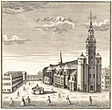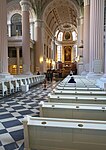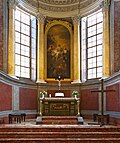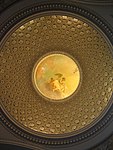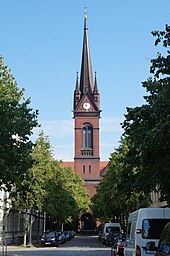Nikolaikirche (Leipzig)
The Nikolaikirche (officially: Stadt- und Pfarrkirche St. Nikolai ) is the oldest and largest church in Leipzig and next to the Thomaskirche the most famous church in the city . The after St. Nicholas called sacred is the main church of the Evangelical Lutheran St. Nikolai church Leipzig. The redesign and furnishing of the interior of the Nikolaikirche represents an important creation of classicism .
In autumn 1989, the Nikolai Church central starting point of the peaceful revolution in the GDR with the subsequent fall of the Wall in Berlin on 9 November 1989 and the reunification of Germany on 3 October 1990th
History and building history
- Historical views
The town and parish church of St. Nikolai was built in Romanesque style from 1165 after Leipzig was granted town and market rights . The Romanesque origin is still visible on the west side of the church. In the 15th and 16th centuries, extensions and the complete conversion to a three-aisled late Gothic hall church took place .
On May 25, 1539, the sermons of the reformers Justus Jonas the Elder and Martin Luther began the Reformation in Leipzig. The church thus became the seat of the first superintendent of the city, Johann Pfeffinger .
In the Nikolaikirche Johann Sebastian Bach performed many of his cantatas and oratorios for the first time with the St. Thomas Choir , including the St. John Passion , his most extensive work to date, on Good Friday, April 7, 1724.
The central tower with the tower house, built 1730–1734 by Johann Michael Senckeisen , is 75 m high. It was inhabited by a tower keeper until 1932 .
In the course of the Enlightenment and revolutionary architecture, the interior of the church was redesigned between 1784 and 1797 according to the ideal of the original hut (trees (columns), canopy, etc.). This is also indicated by the palm column in front of the church, which was erected in 1999. The last major structural changes were made to the outer facade between 1901 and 1902. The late Gothic appearance was retained.

The Monday demonstrations directed against the GDR were directed regime, evolved from Monday asked that the Nikolai Church took place in the early 1980s and were initially visited by only a few people (cf.. Peaceful Revolution (Leipzig) ). In the late November days of 1982, for the first time in the GDR, a large display board with the symbol for swords to plowshares was publicly set up in the Nikolaikirche . At the end of the 1980s, tens of thousands, sometimes even more than 100,000 people, took to the streets of Leipzig every week during the Monday demonstrations to demonstrate for democracy , free elections , freedom of travel and the unity of Germany.
On the Nikolaikirchhof next to the church, a replica of a Dauthean pillar was erected in 1999 based on designs by the Leipzig artist Andreas Stötzner, which is intended as a peace pillar to commemorate the Monday demonstrations and the peacefulness of the revolution. In 1995 Frank Beyer made a film named after the church , which artistically processed the events of 1989.
For decades, the Nikolaigemeinde made its church available to the Leipzig Provost Choir as a rehearsal and performance venue. The provost church was damaged in World War II and later blown up. Even when the Propsteigemeinde was able to move into a new church on the outskirts of the city center, on Rosenthal, in the 1980s, their choir continued to perform in St. Nikolai.
Until March 30, 2008 Christian Führer was pastor of the Nikolaikirche. Bernhard Stief was his successor. The successor to Superintendent and Pastor Martin Henker will be Sebastian Feydt (54), previously pastor at the Frauenkirche in Dresden , in 2020 .
Interior and equipment
The so-called Luther pulpit in the north chapel dates from 1521 . It stood on the third southern pillar of the main nave until 1785. From 1784 to 1797, the interior was fundamentally rebuilt in the classicist style by the Leipzig city architect Johann Carl Friedrich Dauthe . The paintings of the classical furnishings were created by the Leipzig academy director Adam Friedrich Oeser . Dauthe's redesign is influenced by the architectural theory of Marc-Antoine Laugier . The overall concept follows Laugier's demands in the chapter De la difficulté de décorer les églises gothiques of his Observations sur l'architecture (The Hague 1765). Laugier is positive about the Gothic church buildings, but wants to correct them in classical forms and remove elements of medieval furnishings.
According to Laugier's ideas, Dauthe reinterpreted the pillars of the late Gothic hall church into fluted columns of reddish hue by removing or applying a stucco jacket . The light green leaves sprouting from their palm capitals conceal the approach of the Gothic cross vaults. Whose vault fields are classic, with rosettes occupied cassettes become. Everything is based on the color accord white-pink-light green. The Corinthian columns of double order supported galleries are based, however, more Laugier Essai sur l'architecture (Paris 1753, 2nd ed. 1755). In the choir , a wooden barrel vault was drawn in below the medieval vault.
In 1903 the parish of St. Nikolai acquired the two-winged so-called Niedergräfenhainer Altar. The carved altar, created by an unknown master in 1510, stood in the north chapel until 1943 and only found its place there long after the Second World War.
A simple wooden cross was placed on a metal stand next to the main altar in 1982 for the first prayer for peace.
With more than 1400 seats, the Nikolaikirche is one of the largest churches in Saxony.
Ceiling painting by Adam Friedrich Oeser
Organs
An organ is mentioned for the first time in 1479, which was built in the south aisle. Hermann Raphael Rodensteen worked several times on the instrument. Johann Lange built a new movement (II / P / 27) from 1597–1598, Valentin Silbermann the case and Thomas Lichtenstein and his journeyman Heinrich Eckersen the side panels. The case was renewed from 1625 to 1626 and the work was repaired by Andreas Werner after war damage from 1638 to 1639. Zacharias Thayßner expanded the instrument to III / P / 36 in 1693–1694. After a renovation by Johann Scheibe in 1725, repairs by Zacharias Hildebrandt 1739–1740 and 1750–1751 followed.
In the years 1785–1787, the organ builder Johann Gottlob Trampeli replaced the missing instrument with a new one. The slider chest instrument had 48 stops on three manuals and a pedal. The actions were mechanical.
|
|
|
|
||||||||||||||||||||||||||||||||||||||||||||||||||||||||||||||||||||||||||||||||||||||||||||||||||||||||||||
A small organ is attested in 1506. It was replaced in 1577 by an instrument from Rodensteen (I / 8), which was removed by Thayßner in 1693.
Ladegast instrument from 1862
Today's organ goes back to an instrument that was built in 1862 by the organ builder Friedrich Ladegast (Weißenfels) with mechanical action and 83 stops on four manuals and pedal . Ladegast's sound pattern differed significantly from that of French organs of the time, e.g. from Cavaillé-Coll. In Ladegast's organ there were nine reeds, five of which were resounding, and under the manual registers there was only one striking reed, a trumpet. The E of the Principalbass 32` is the largest prospect pipe.
|
|
|
|
|
||||||||||||||||||||||||||||||||||||||||||||||||||||||||||||||||||||||||||||||||||||||||||||||||||||||||||||||||||||||||||||||||||||||||||||||||||||||||||||||||||||||||||||||||||||||||
- Remarks:
The whole organ contained a Barker machine . The organ was then (and is again today) the largest organ in Saxony and helped shape the romantic interpretation of Johann Sebastian Bach's organ compositions in the second half of the 19th century. Later, Ladegast rebuilt the organ, equipped it with further Barker machines, and tuned it a little lower, to the tone common around 1885.
Between 1902 and 1903 the organ was rebuilt and expanded by the Wilhelm Sauer company (Frankfurt / Oder). The sound changed from a highly romantic to a typically German-late romantic. The pipework was largely retained, the originally mechanical slider chests were replaced with pneumatic cone chests, a modern gaming table was installed, and the wind turbine was relocated to the main housing. Reviewers found some Sauer registers to be unsuccessful and criticized the fact that Sauer had not managed to turn Ladegast's work into a typical Sauer organ.
In 1934, inspired by the organ movement , attempts were made to make the Ladegast-Sauer organ baroque. In doing so, twelve registers were exchanged for neo-baroque ones. However, these mixed poorly with the rest of the pipe inventory, so that they rather brightened the sound as a foreign body. In addition, they were too weak to lighten the fundamental tonal image to such an extent that it is equivalent to a baroque one.
In the course of a restoration of the instrument between 1986 and 1988, the actions were electrified by VEB Orgelbau Sauer (Frankfurt / Oder).
Today's instrument
After the fall of the Wall, the interior was to be renovated. After this, the organ had to be cleaned, so it was considered how the organ, which at that time had 94 registers, could be improved on the occasion. Among other things, the space requirements for the wind turbine installed by Sauer and the cone store meant that the organ was “totally built in” inside, which hindered the sound radiation. In the years 2002-2003 the instrument was then technically rebuilt by the organ manufacturer Hermann Eule in Bautzen, based on the historical organ and reusing the preserved historical substance in the Ladegasts style, with slide chests and mechanical action mechanisms, and in the historical case of Erected again in 1862:
a) The original Ladegasts disposition from 1862 was restored, for which nine registers had to be reconstructed. If the organist knows this disposition, he can now register a sound like the one produced by the organ in 1862.
b) However, they did not want a radical restoration to the state of 1862, but viewed the registers added by Sauer as a historically grown component that should be preserved. Since the Sauer registers corresponded to a different sound ideal than that of Ladegast, and were set to a higher wind pressure, it would have been unfavorable to mix them unchanged with Ladegast's original arrangement.
c) The Eule company built a new, fifth manual (the Schwellwerk), mainly to accommodate Sauer stops that are difficult to integrate.
d) In order to connect the sound between the Sauer registers and the Ladegast disposition, the Eule company built eleven additional, new registers, mainly reed voices, distributed throughout the organ.
The new gaming table was designed and sponsored by designers from Porsche AG. The gaming table has round wind pressure indicators that are reminiscent of a dashboard. The registration system is electric, the action mechanical, and partly supported by Barker machines. The organ has 102 stops on five manual works and a pedal.
|
|
|
|
|
||||||||||||||||||||||||||||||||||||||||||||||||||||||||||||||||||||||||||||||||||||||||||||||||||||||||||||||||||||||||||||||||||||||||||||||||||||||||||||||||||||||||||||||||||||||||||||||||||||||||||||||||||||||||||||||||||||||||||||||||||||||||||||||||||||||||||||||||||||||||||||||||||||||||||||||||||||||||||||||||||||||||||||||||||||||||||||||||||||||||||||||||||||||||||||||||||||||||||||||||||||||||||||||||||||||||||||||||||||||||
-
Pairing :
- Normal coupling: II / I, III / I, IV /, III / II, IV / II, IV / III, V / VI, I / P, II / P III / P, IV / P, V / P
- Super octave coupling: III / P
- Sub-octave coupling: III / I
- Playing aids : 4000-fold setting system , crescendo roller , storage
- Remarks:
- T = register largely from Trampeli
- L = stock from 1862 (Friedrich Ladegast)
- S = register from 1903 (Sauer)
- R = register reconstructed according to Ladegast (Eule, 2004)
- E = new register from owl (2004)
During the renovation and restoration work on the Ladegast organ, the op. 644 from the Eule company, a two-manual organ with 17 registers built in 2002 based on Italian models, was available as an interim organ near the choir. This organ has been in the Marienkapelle of Naumburg Cathedral since 2012. For a long time, the interim organ was replaced by a small organ made by Alexander Schuke from the 1950s.
Organists and cantors
- Johann Rosenmüller , 1651–1655
- Adam Krieger , 1655–1657
- Elias Nathusius , 1657–1676
- Gottfried Vopelius , 1677– ??
- Johann Gottlieb Görner , 1721–1723
- Johann Sebastian Bach , 1723-1750
- August Eberhard Müller , 1794–1804
- Adolph Heinrich Müller , 1804–1837
- Carl Ferdinand Becker , 1837-1854
- Christian Hermann Schellenberg , 1854–1862
- Ernst Friedrich Richter , 1863–1868
- Robert Papperitz , 1868–1899
- Carl Heynsen , 1900–1926
- Karl Hoyer , 1926–1936
- Walter Zöllner , 1936–1942
- Johannes Piersig , 1942–1959
- Wolfgang Hofmann , 1959–1993
- Jürgen Wolf , 1993 – March 2019
- Stephan Gogolka (interim choir director), March 2019 – March 2020
- Lucas Pohle , from March 2020
Bells
In 1452 the first bell was hung in the north tower of the Nikolaikirche: The bell was named Osanna ; it was decorated by Nikolaus Eisenberg with depictions of the crucified Jesus and the four evangelists , St. Martin and the patron saint of this church, St. Nicholas. The bell not only rang the services, but was also used as a fire bell .
In 1633 the Osanna from 1452 was damaged by fire; shortly afterwards it burst when a bell rang. The bell founder Jakob König (Erfurt) melted the remains of the bell in 1634 and cast a new "Osanna" weighing "114 Centers". After this bell cracked in 1867, the Leipzig bell foundry Gustav Adolph Jauck cast a complete new ring with four bells in 1869. The largest bell (also "Big Bell", "Osanna") with the strike tone g 0 weighed 4055 kg and was hung in the south tower; its inscription read: HONOR TO GOD AT HEIGHT - In Christ Jesus we have redemption through his blood, namely the forgiveness of sins Eph. 4,7 ... In the north tower three bells were hung: the "Bride Bell" (2,060 kg) with the chime h 0 , the " Confession Bell " (1,220 kg) with the chime d 1 and the "Morning Bell" (520 kg) with the strike note g 1 .
In 1917 three bells had to be given to the armaments industry. When the "Big Bell" was lifted from the south tower, the tether broke; the bell penetrated almost half a meter into the pavement, but is said to have remained undamaged. In addition to the "Osanna", the bridal bell and the morning bell were also transported away to be melted down. Only the confessional bell and the chime bell could be saved with a protection certificate from the Kunstgewerbemuseum . The belfry and the wooden yoke in the south tower were preserved.
In July 1925 Otto Schilling ( Apolda ) cast two new bronze bells with the diameters 2150 and 1280 mm and the striking notes h 0 and e 1 . Before the Second World War, the Nikolaikirche had three chiming bells.
In December 1941 the two larger bells of the peal (with the chimes h 0 from 1925 and d 1 from 1869) were confiscated for the armaments industry. The Nikolaigemeinde only kept the e 1 bell from 1925. The chiming bell was also intended to be melted down. In order to let them out of the tower, vaults would have had to be pried open, which would jeopardize the stability of the tower. That is why the clock bell was left hanging in the tower.
In 1964, the bell founder Franz Schilling cast two new bells. Both bells were cast in a newly constructed, lighter rib with reduced diameters, as there were concerns about whether the new large bell with a diameter of 1.60 m could be mounted and rung in the still existing bell cage. The two sounding bodies have the same chimes as the two bells confiscated in 1941 (h 0 and d 1 ); they bear the inscriptions: "Glory to God in the highest and peace on earth and a pleasure to men". It is the words that carried the bells of 1869.
The parish had set itself the goal that on the 30th anniversary of the Peaceful Revolution on October 9, 2019, a new ring with eight bells should sound. There was also a fundraising campaign with the goal of 136,000 euros. The names of the bells and their inscriptions were fixed.
Since June 30, 2019 hanging in the towers of the Nikolaikirche eight bronze bells : supplemented the two bells from 1964 by six new bells from the bell foundry Bachert , Neunkirchen (Baden) . The new bells are considered successful in terms of casting technology and sound. Osanna , the lowest bell, measured a decay time of over 300 seconds. It was cast from bronze with 78% copper and 22% tin and lifted into the south tower on June 30, 2019, for which the street-side soundhole of the tower had to be pried open. The Osanna hangs in the restored belfry from 1869, which already carried the large bell by Gustav Adolph Jauck (1869). Since the new Osanna with 6700 kg turned out to be significantly heavier than planned (approx. 6000 kg), additional, expensive work on the clapper and yoke, as well as a revision of the structural design, became necessary. The other seven chimes hang in the north tower.
The e 1 bell from 1925 does not match the new bell. She was placed in a church storage room until a new location was found for her.
| No. | Surname | Casting year | Caster | Diameter (mm) |
Weight (kg) |
Nominal (16th note) |
Inscription, notes |
|---|---|---|---|---|---|---|---|
| 1 | Osanna | 2019 | A. Bachert , Neunkirchen | ~ 2,120 | 6,700 | g 0 −3 | Festive bell inscription: Blessed are those who hear and keep the word of God. (Luke 11:28) |
| 2 | Gloria | 1964 | Bell foundry family Schilling in Apolda | 1,584 | 2,342 | h 0 -3 | Resurrection Bell Blessed are you who weep now; because you will laugh. (Luke 6:21) |
| 3 | Kyrie | 1.310 | 1,284 | d 1 −4 | Prayer Bell Blessed are those who hunger and thirst for righteousness; because they should be full. (Matthew 5,6) |
||
| 4th | Creed | 2019 | A. Bachert , Neunkirchen | ~ 1,225 | 1,065 | e 1 −3 | Confession Bell Blessed are those who are persecuted for the sake of righteousness; for theirs is the kingdom of heaven. (Matthew 5:10) |
| 5 | Pax | ~ 1,150 | 900 | f sharp 1 −3 | Bell of Peace Blessed are the peacemakers ; for they will be called children of God. (Matthew 5: 9) |
||
| 6th | Benedictus | ~ 1,060 | 710 | g 1 −1 | Blessing Bell Blessed are the merciful; for they will receive mercy. (Matthew 5,7) |
||
| 7th | Sanctus | ~ 965 | 545 | a 1 −1 | Wedding bell Blessed are the pure in heart; for they will see God. (Matthew 5, 8) |
||
| 8th | Agnus Dei | ~ 880 | 420 | h 1 −1 | Baptismal Bell Blessed are those who do not see and yet believe! (John 20, 29) |
Attractions
- Grave of Petrus Mosellanus
Varia
- A slightly oversized horseshoe is located in a niche on the southern outside of the choir. Its origin is unclear. That's why legends entwine around it. One attributes it to the horse of St. George, which it lost during the fight between George and the dragon. Another connects it with the death of Landgrave Diezmann in Leipzig in 1307, whose horse lost a horseshoe during a pursuit through the city, which was thrown into the Nikolaikirche.
- The horseshoe, in which a former guild mark of a Leipzig master blacksmith can be assumed, was important for traveling journeyman craftsmen who, with precise knowledge of the location of this landmark, could prove to have been in Leipzig.
- The writer Erich Loest deals with the events around the Nikolaikirche from 1987 to 1989 in his novel Nikolaikirche , published in 1995 . The book was also made into a film in 1995 .
- The writer Martin Jankowski , who for many years helped to shape the prayers for peace himself, paints a somewhat different picture from the perspective of young oppositionists in his novel Rabet or The Disappearance of a Cardinal Direction .
- The Holy Cross Church in the Neustadt district of Leipzig is the second place of worship in the parish of St. Nikolai alongside the Nikolaikirche .
- Sir Colin Mawby composed the oratorio Ecce homo in memory of Pastor Christian Führer , which was premiered on May 26th, 2016 with over 200 participants in the Nikolaikirche under the direction of Frank Steffen Elster (Gewandhaus zu Leipzig). It is dedicated to "all women, men and children who try to follow the inner voice of their conscience despite danger, persecution and fear - like the demonstrators of the Peaceful Revolution on October 9, 1989 in Leipzig".
literature
- Cornelius Gurlitt : Nikolaikirche. In: Descriptive representation of the older architectural and art monuments of the Kingdom of Saxony. 17th booklet: City of Leipzig (Part I) . CC Meinhold, Dresden 1895, p. 3.
- Heinrich Magirius : Nikolaikirche Leipzig. (= Little Art Guide. 1870). Schnell & Steiner, Munich 1991.
- Karl Czok: The Nikolaikirche Leipzig. Edition Leipzig 1992, ISBN 3-361-00390-3 .
- Heinrich Magirius: The redesign of the interior of the Nikolaikirche in Leipzig by Johann Carl Friedrich Dauthe 1784 to 1797. In: Built past today - reports from the preservation of monuments. Berlin / Munich 1993, ISBN 3-345-00530-1 , pp. 121–152.
- Christian Dietrich, Uwe Schwabe (ed.): Friends and enemies. Prayers for peace in Leipzig between 1981 and October 9, 1989. Evangelische Verlagsanstalt, Leipzig 1994.
- Reinhard Wegner: Gothic and Exotic in the Age of Enlightenment. The renovation of the Nikolaikirche in Leipzig. In: German architecture around 1800. Böhlau, Cologne a. a. 2000, pp. 53-63.
- Martin Jankowski : The day that changed Germany - October 9, 1989. Evangelische Verlagsanstalt, Leipzig 2007, ISBN 978-3-374-02506-0 .
- Armin Kohnle (Ed.): St. Nikolai zu Leipzig. 850 years of the church in the city. Imhof, Petersberg 2015, ISBN 978-3-86568-857-6 .
- St. Nikolai in Leipzig. 850 years of the church in the city. Imhof, Petersberg 2015, ISBN 978-3-86568-857-6 . (Review:.)
- Alberto Schwarz: The old Leipzig - cityscape and architecture. Beucha 2018, ISBN 978-3-86729-226-9 , pp. 85-86.
Web links
- Official website of the Nikolaikirche Leipzig
- Video with outside and inside views
- Christian Hans Schulz: The Sound of Freedom - New Bells for St. Nikolai (documentary, 45 minutes). Mitteldeutscher Rundfunk , online portal, October 5, 2019. Accessed October 5, 2019 .
Individual evidence
- ^ Nikolaikirche Leipzig: Brief building history , accessed on May 6, 2017.
- ↑ Go Vista City Guide Leipzig. Vista Point Verlag, Cologne 2005, ISBN 3-88973-646-7 , pp. 12-13.
- ^ Religion in the heart of the city - The Nikolaikirche in Leipzig. (PDF) Retrieved January 23, 2019 .
- ↑ Dresden Frauenkirchen pastor Feydt appointed Leipzig Superintendent , accessed on January 26, 2020
- ^ Christoph Wolff , Markus Zepf: The organs of JS Bach. A manual . Evangelische Verlagsanstalt, Leipzig 2006, ISBN 3-374-02407-6 , p. 68 .
- ↑ Information on the organ
- ^ Ulrich Dähnert: Historical organs in Saxony. An organ inventory . VEB Deutscher Verlag für Musik, Frankfurt 1980, ISBN 3-920112-76-8 , p. 182 .
- ↑ Information on the disposition of the Ladegast organ
- ↑ a b c Email from Jiri Kocourek (Artistic Director of the Eule-Orgelbau company) to the author
- ↑ nikolaikirche.de
- ↑ Radio show “Organ magazine: Friedrich Ladegast for his 200th birthday (4). The large organ of the Nikoilaikirche in Leipzig (1862) - reconstructed and extended by the Hermann Eule Bautzen company (2003) Interview with Jiri Kocourek (artistic director of the Eule company) ”. MDR Kultur , March 18, 2018.
- ↑ More information on the history and disposition of the organ of the Nikolaikirche on the website of the company Eule.
- ↑ Greystyle.com - Graphic & Web Design: Evangelical Church Community Naumburg / Saale. Retrieved September 4, 2018 .
- ↑ Hermann Eule organ building Bautzen
- ↑ https://foerderverein.bachchor-leipzig.de/de/chorleiter/ , accessed on January 27, 2020
- ↑ https://www.nikolaikirche.de/mitteilungen/lucas-pohle-wird-neuer-nikolaikantor/ , accessed on January 27, 2020
- ↑ https://www.highresaudio.com/de/artist/view/6aa0c0c6-c2bd-4d2d-b42b-756c96314328/lucas-pohle , accessed on January 27, 2020
- ↑ https://www.lvz.de/Nachrichten/Kultur/Kultur-Regional/Neuer-Nikolaikantor-in-Leipzig-Orgelherbst-startet , accessed on August 2, 2020
- ^ Peter Schwarz: The millennial Leipzig. From the beginning to the end of the 18th century . 1st edition. tape 1 . Pro Leipzig, Leipzig 2014, ISBN 978-3-945027-04-2 , pp. 153 .
- ↑ https://www.mdr.de/entdecke/edo-nikolaikirche100.html
- ↑ Information board with a photo of Osanna stuck in the pavement, was put up in the Nikolaikirche in the 1980s.
- ↑ a b Detailed description of the bell history on the Nikolaigemeinde website: https://www.nikolaikirche.de/newsletter/geschichten-der-glocken/
- ↑ Information on the history of bells
- ↑ Friedemann Szymanowski: The bells of the Nikolaikirche - history and stories. In: www.nikolaikirche.de, online portal. May 6, 2018, accessed May 13, 2018 .
- ↑ Osanna and her five "sisters" - trial ringing: This is how the new bells in Leipzig's Nikolaikirche sound. In: Leipziger Volkszeitung . October 1, 2019, accessed on October 3, 2019 : “At first it was a warm bass tone that floated over the city of Leipzig on Tuesday. Then there were seven higher notes. In the Nikolaikirche the intonation of the new eight-part bells will take place these days. The Osanna, the new largest church bell in the city, can also be heard for the first time. "
- ^ Christian Hans Schulz: The sound of freedom - New bells for St. Nikolai (documentary, 45 minutes). Mitteldeutscher Rundfunk , online portal, October 5, 2019. Accessed October 5, 2019 .
- ↑ Call for donations: Turn 1 into 3. In: www.nikolaikirche.de, online portal. May 6, 2018, accessed May 13, 2018 .
- ↑ Susan Künzel: Nomen est omen - The bells for the Nikolaikirche have names. In: www.nikolaikirche.de, online portal. May 6, 2018, accessed May 13, 2018 .
- ↑ Information on the bells of the Nikolaikirche and plans for an updated chime , Leipziger Volkszeitung ; Retrieved April 17, 2017.
- ↑ BACHERT. Retrieved June 22, 2019 .
- ↑ a b c https://www.lvz.de/Leipzig/Lokales/Leipziger-Nikolaikirche-weiht-sechs-neue-Glocken-auf-einmal
- ↑ Ingrid Hildebrandt and Mark Daniel: Solemn act: New bells for Leipzig Nikolaikirche - Osanna lifted in on Sunday. In: Leipziger Volkszeitung , online portal. June 30, 2019, accessed July 1, 2019 .
- ↑ Dominic Welters: New super bell for St. Nikolai: The financing is in place. In: Leipziger Volkszeitung , online portal. January 21, 2019, accessed March 3, 2019 .
- ^ Dpa: New bells for Nikolaikirche in Leipzig. In: www.nikolaikirche.de, online portal. January 8, 2019, accessed March 3, 2019 .
- ↑ Leipzig Nikolaikirche - three bells raised, five cast. Retrieved October 3, 2019 .
- ^ Wilhelm Schäfer: The horseshoe at the Nikolaikirche. In: German city landmarks: their origins, history and Interpretation. Volume 1, Verlagbuchhandlung JJ Weber, Leipzig 1858, pp. 18–24 ( digitized version of the book )
- ^ Johann Georg Theodor Grasse: The horseshoe at the Nicolaikirche in Leipzig. ( Wikisource )
- ↑ Claus Uhlrich: The Marienborn and other stories from old Leipzig. ProLeipzig, 2001, ISBN 3-9807201-8-7 , p. 67.
- ↑ Erich Loest: Nikolaikirche . German Taschenbuch-Verlag, Munich 1997, ISBN 3-423-12448-2 .
- ↑ Martin Jankowski: Rabet or The Disappearance of a Cardinal Direction. via verbis Munich 1999, ISBN 3-933902-03-7 .
- ↑ Burkhard Kunkel: Review of: St. Nikolai zu Leipzig. 850 years of the church in the city, Petersberg 2015 . In: New archive for Saxon history . No. 86/15 . Neustadt ad Aisch 2015, p. 340-342 .
Coordinates: 51 ° 20 ′ 25 " N , 12 ° 22 ′ 42.8" E





